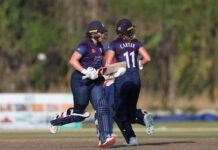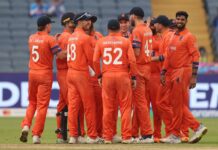In a week where cricket grounds the world over remained locked, it was the off-field happenings which drew attention from a sport-starved public. South African offspinner Dane Piedt announced on Friday that he had signed up for the USA’s Minor League T20, in a move that saw him move on from South Africa after a decade-long career with the Cape Cobras and 9 Test matches. Speaking to ESPNCricinfo, he confirmed that fellow ex-Protea Rusty Theron had been instrumental in his recruitment, and that he harboured ambitions to qualify for the USA national team and potentially play at the 2023 Cricket World Cup.
In what turned out to be a prescient discussion with American cricket journalist Peter Della Penna, this week’s Emerging Cricket podcast covered that exact topic, as Della Penna analysed the potential impacts of USAC signing up first-class players for the planned Minor League tournament:
“The concern from the US-eligible players and the domestically developed players is that the overseas players that are going to be recruited… once they hit the three-year residency threshold, they’re just gonna get fast-tracked straight into the US team.”
Listen from the 27:45 minute mark of our latest pod to hear Peter Della Penna discussing the issue:
Piedt’s pursuit of an American dream is, on one level, merely a pragmatic career decision. People in many professions move home for employment opportunities and athletes are no different in that regard. Conversely, his presence is hoped to benefit US cricket by raising the standard; as well as off-field development work, US administrators have justified their selection policies on the basis that they need to put the best side onto the field, so if recruiting from overseas helps them to do that, why wouldn’t they? As Della Penna summarised,
“The USA, or any other country for that matter, is going to look a bit foolish if they’re taking a principled moral stance of ‘we’ll only pick homegrown players’… If USA administrators take this principled stance, you’re going to put yourself at risk of falling back, losing ODI status, losing funding, losing fixture opportunities.”
However, for a national sports administration, and especially one of a niche sport looking to expand (as cricket is in the USA), there are more considerations than merely putting the best national team onto the field at any given time. The sustainability of the local scene is vital to long-term success of the game, and administrators have for years held the goal of growing cricket into the mainstream sporting consciousness. Indeed, the topic of youth development was an important discussion point at an ICC-run town hall meeting held some five years ago as various parties involved in American cricket attempted to move forward in the aftermath of the former board USACA’s suspension. So to rely on ex-pros from Full Member nations would appear to be a regression, a return to the unsuccessful approach of the previous administration.
And while it may bring a measure of onfield success in the short term, there is a danger that it undercuts the long-term inspirational function of the national team, where playing for one’s country is supposedly the culmination of a meritocratic pathway from the grassroots game, and an incentive for young players to pick up a bat or ball. If USA Cricket is diverting funds from local development initiatives to sponsoring foreign players, serious questions are raised as to both the overall value proposition of the Minor League project, and the ultimate point of the national team – if local players can’t see themselves in the side, will they aspire to play in it? Della Penna again addressed this point:
“The concern from local players is that the cycle is just going to perpetuate itself. And it’s just going to discourage the locally developed players more and more, and instead of giving them more hope, and giving them more opportunities to have a professional career and go on and represent USA, they’re going to be less incentivised and they’re just going to say, ‘forget it, I’ll go play basketball, I’ll go play tennis, I’ll go pursue a non-cricket career in finance or whatever other field’, and you’re just gonna have the cycle continue and I think that’s one of the big question marks.”
The other question mark of course, is how beneficial it even is bringing in players at the tail end of their Full Member careers to play for the USA national team. As the standard of Associate cricket has improved over the years, so the comparative value of a mediocre FM player has decreased. The abysmal record (but continuing selection) of former West Indies Test player Xavier Marshall in Associate cricket, and Rusty Theron’s diminished returns for USA compared with his South African numbers both act as a counterargument to the implicit assumptions held by selectors that if a player has experience in a major cricketing country they will necessarily be better than locally produced players. And with the USA national team already flush with spinners (led by the youthful left-armer Karima Gore), it remains to be seen how much of an impact Piedt will even have.
If you want to hear the team discussing these and other stories in more detail, add the Emerging Cricket Podcast to your favourites on Apple, Spotify and Podbean.
You can also keep up with news and events from cricket’s new world on our Facebook and Twitter pages.







